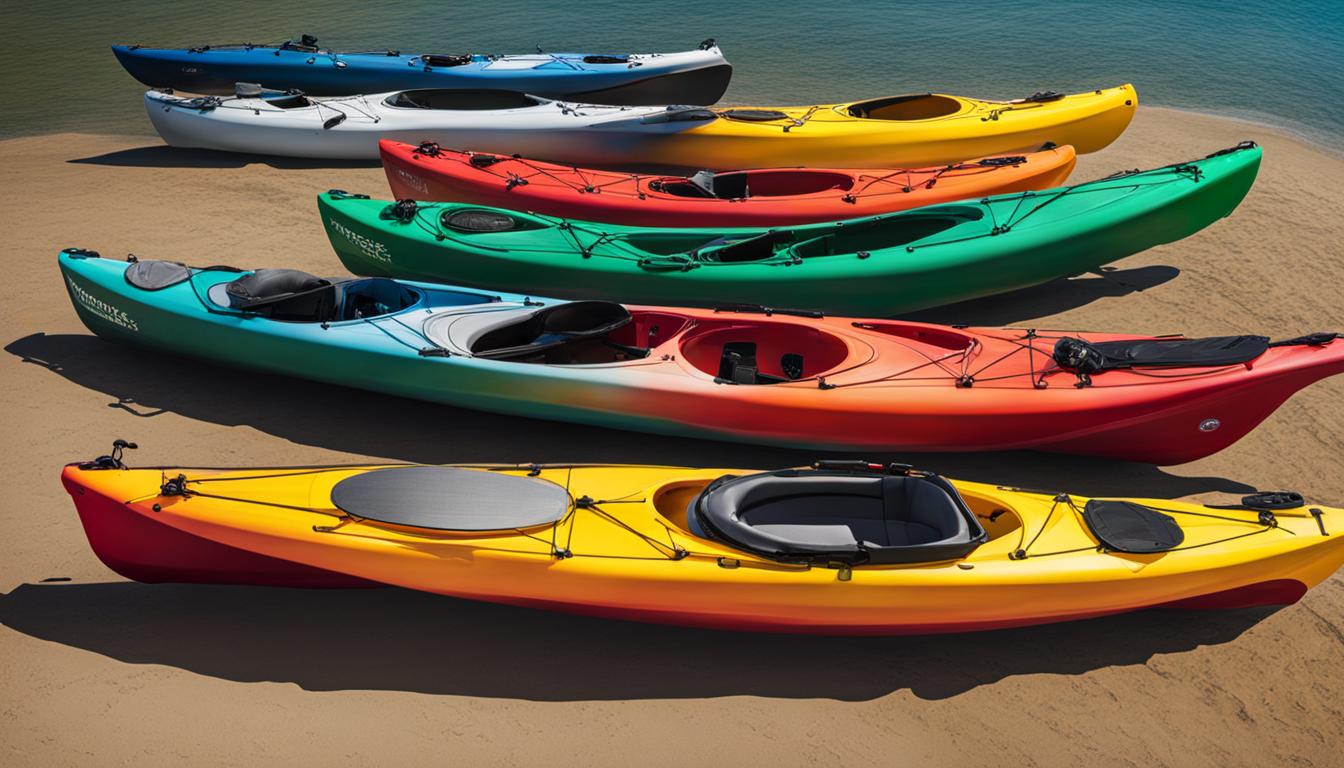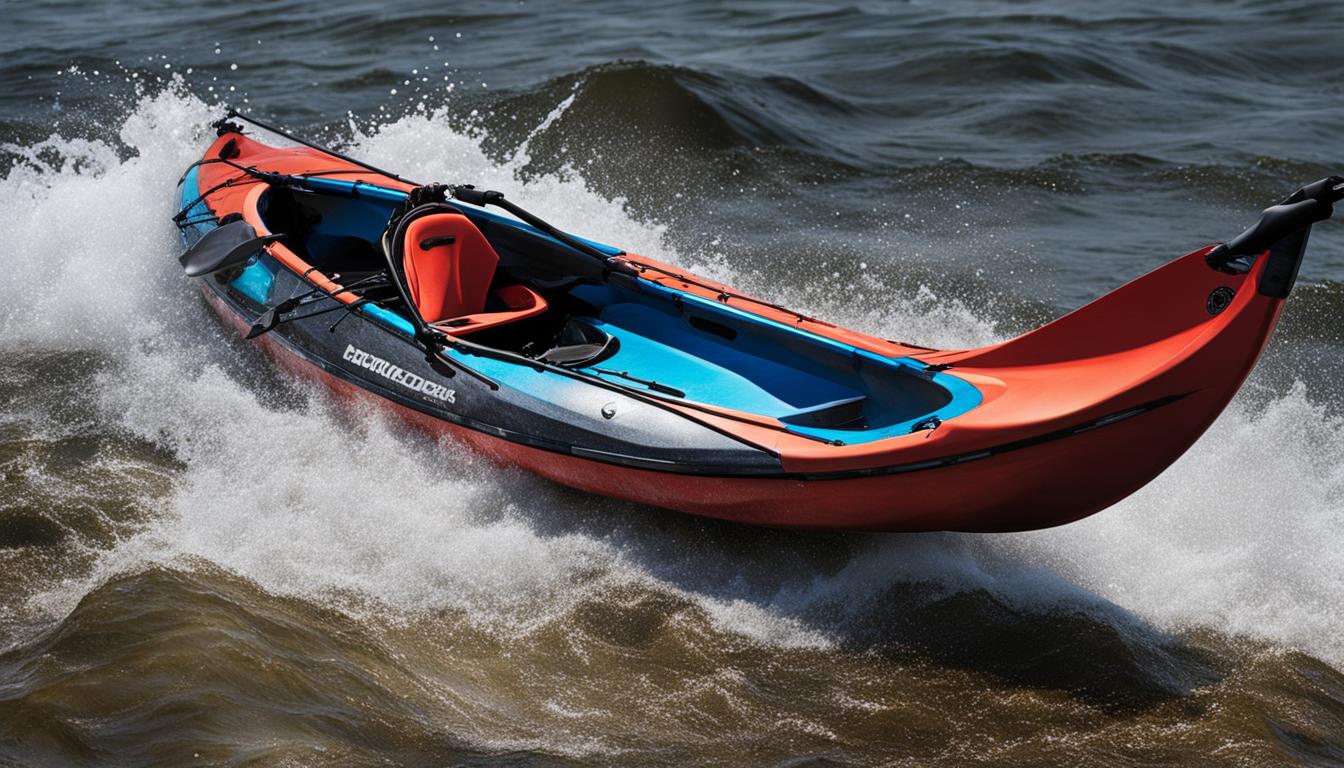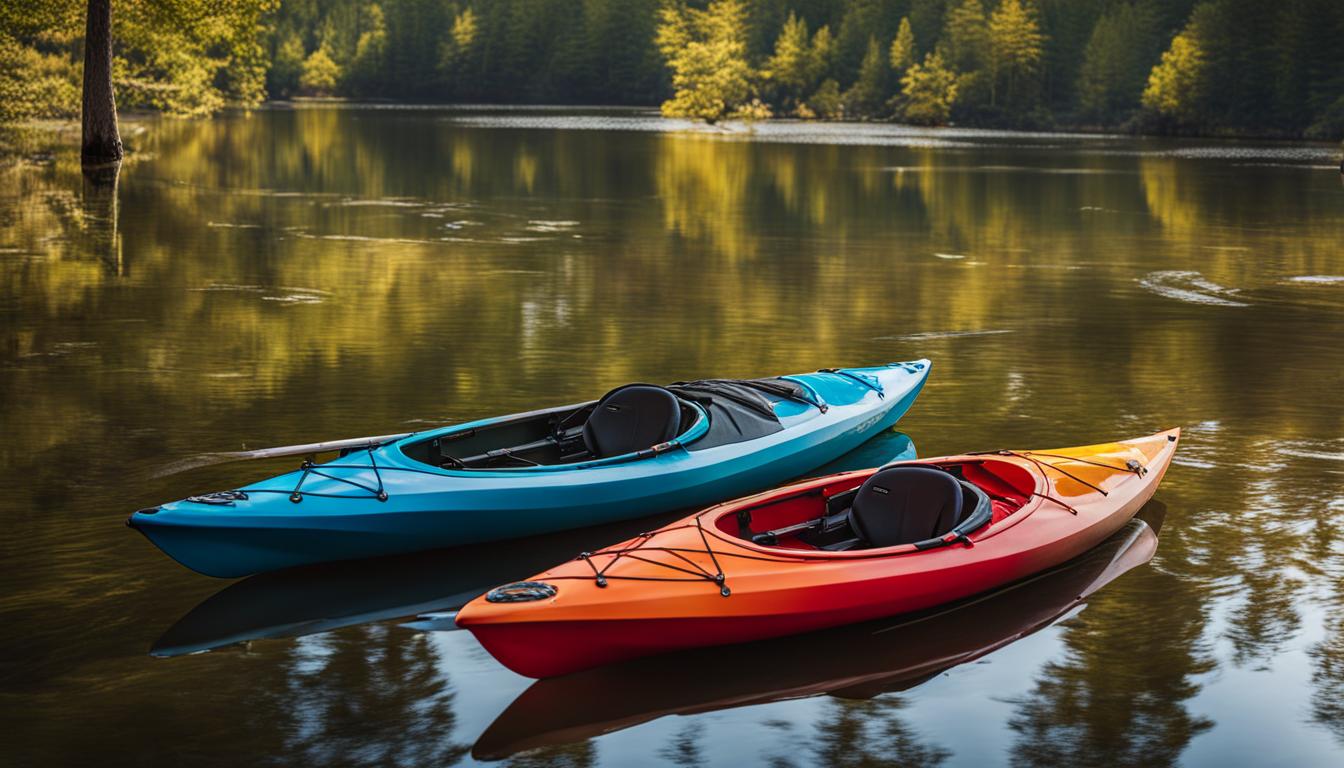Welcome to our comprehensive guide on understanding the costs associated with kayak maintenance. Whether you own a kayak rental business or are an avid kayaker yourself, it’s important to be aware of the expenses involved in maintaining this exciting watercraft. From storage fees to repair costs, we’ll delve into the various factors that contribute to the overall cost of owning and maintaining a kayak.
Key Takeaways:
- Running a successful kayak rental business involves several operating expenses.
- Expenses include storage rent, kayak purchase or leasing costs, employee salaries, insurance premiums, advertising expenses, maintenance and repair costs, utility bills, cleaning supplies, and license fees.
- Understanding these costs helps in creating a budget and maximizing revenue.
- Rent for storage facilities is a significant expense for kayak rental businesses, ranging from $50 to $500 per month.
- The cost of purchasing or leasing kayaks varies based on their type, material, and quality, with prices ranging from $300 to $2000.
Rent for Storage Facilities
When running a kayak rental business, one of the significant costs to consider is the rent for storage facilities. The storage facility provides a safe and secure place to store your kayaks when they are not in use. The rental cost for storage facilities can vary depending on several factors, including location, size, and amenities.
The average monthly rent for storage facilities in the United States ranges from $50 to $500. However, it’s important to note that these prices can vary significantly depending on the specific location and the services offered by the facility. For example, storage facilities located in prime waterfront areas or with additional security features may charge higher rent than facilities in less desirable locations.
When choosing a storage facility, it’s crucial to consider your specific needs and budget. Look for a facility that offers the appropriate size to accommodate all of your kayaks and has the necessary amenities, such as 24-hour access, climate control, and security measures. Assessing the value for money is also important, as you want to ensure that the rent charged aligns with the services and benefits provided by the facility.
| Location | Size | Amenities | Rent Range |
|---|---|---|---|
| City A | Small | Basic | $50 – $100 |
| City B | Medium | 24-hour Access | $150 – $300 |
| City C | Large | Climate Control, Security | $400 – $500 |
By carefully considering the rent for storage facilities and selecting the right option for your kayak rental business, you can effectively manage your expenses and provide a secure location for your kayaks.
Cost of Purchasing or Leasing Kayaks
When starting a kayak rental business, one of the crucial decisions you’ll face is whether to purchase or lease kayaks. The cost of acquiring kayaks can vary depending on various factors such as the type, material, and quality of the kayaks. Let’s explore the different options and their respective costs.
Buying a Kayak
If you decide to buy kayaks, you’ll have the advantage of long-term ownership and the ability to customize your fleet to meet specific customer demands. The price range for purchasing kayaks typically falls between $300 and $2000. Recreational kayaks, which are perfect for beginners and casual paddling, are generally more affordable. On the other hand, specialized kayaks like fishing or sea kayaks tend to be more expensive due to their additional features and materials.
It’s worth noting that purchasing kayaks requires a significant upfront investment, but it can be a cost-effective option if you anticipate steady demand and plan to operate the business for an extended period. Additionally, buying kayaks allows you to maintain full control over their maintenance and repair, potentially reducing long-term expenses.
Leasing a Kayak
If you’re looking for a more flexible and budget-friendly option, leasing kayaks might be a suitable choice. Leasing allows you to access a fleet of kayaks without the need for substantial upfront capital. Typically, the cost of leasing a kayak ranges from $25 to $35 per day. This pricing structure is particularly advantageous for businesses operating in seasonal locations or those not yet sure of long-term demand.
Leasing also provides the benefit of maintenance and repair services, as they are often included in the lease agreement. This means you won’t have to worry about additional expenses or the logistics of handling repairs yourself.
| Kayak Type | Price Range |
|---|---|
| Recreational Kayaks | $300 – $700 |
| Fishing Kayaks | $700 – $1500 |
| Sea Kayaks | $1000 – $2000 |
Choosing between purchasing and leasing kayaks depends on various factors, including your budget, expected demand, and long-term business goals. It’s advisable to conduct thorough market research and financial analysis to make an informed decision that aligns with your business strategy. Remember, the cost of purchasing or leasing kayaks is a significant investment, so it’s crucial to choose wisely to ensure the success and profitability of your kayak rental business.

Employee Salaries and Benefits
When operating a kayak rental business, one of your significant expenses will be employee salaries and benefits. It’s important to budget carefully and offer competitive compensation packages to attract and retain top talent. By investing in your employees, you can decrease turnover, increase productivity, and provide excellent customer service.
In the United States, the median hourly wage for water transportation workers, which includes employees in the kayak rental industry, is $22.20 as of May 2021. This wage may vary depending on factors such as location and employee experience. Additionally, providing healthcare benefits for your employees is crucial. In 2020, the average cost to provide healthcare benefits for one employee was $7,470.
Offering competitive salaries and benefits not only helps you attract skilled employees but also ensures their loyalty and commitment to your business. This, in turn, can positively impact the overall success of your kayak rental venture. Remember to budget carefully for these expenses and explore options such as group insurance plans to make the most cost-effective choices for your business and employees.
“Investing in your employees can lead to decreased turnover, increased productivity, and improved customer service.”
Employee Salaries and Benefits – Key Points:
- Water transportation workers in the kayak rental industry earn a median hourly wage of $22.20 as of May 2021.
- The average cost to provide healthcare benefits for one employee is $7,470.
- Offering competitive compensation packages can help attract and retain top talent.
- Budget carefully for employee salaries and benefits, considering factors such as location and employee experience.
- Explore options like group insurance plans to make cost-effective choices for your business and employees.
Insurance Premiums for Liability Coverage
When it comes to running a kayak rental business, one of the significant costs to consider is insurance premiums for liability coverage. As a responsible business owner, it’s crucial to protect yourself and your customers against any potential risks and liabilities that may arise during kayak rentals.
The average cost for general liability insurance for small businesses is typically between $400 and $600 per year. However, it’s important to note that premiums for kayak rental businesses may be higher due to the specific risks and hazards associated with water-based activities.
Several factors can influence the cost of insurance premiums for a kayak rental business. These factors include the number of employees, the location of your rental operation, the type of kayaks you offer, and the frequency of rentals. Insurance providers take these factors into account to determine the appropriate coverage and corresponding premiums.
Having adequate liability coverage is essential to protect your business from potential legal claims and damages. Accidents can happen, and having insurance in place can provide peace of mind for both you and your customers. Remember, the cost of insurance is an investment in the long-term sustainability and success of your kayak rental business.

The Value of Liability Insurance
Liability insurance protects your business from expenses related to third-party claims of bodily injury or property damage. Whether it’s an accident on the water or a customer slipping and falling at your rental location, liability insurance provides coverage for legal defense costs, settlements, and judgments.
Without proper insurance coverage, your business could be held liable for medical expenses, property repairs, and legal fees, which can be financially devastating. By investing in liability insurance, you can safeguard your business and ensure that you have the necessary resources to handle unexpected situations that may arise.
Choosing the Right Insurance Provider
When it comes to selecting an insurance provider for your kayak rental business, it’s important to consider a company with expertise in the outdoor recreation industry. Look for insurers that specialize in liability coverage for water-based activities and have a thorough understanding of the unique risks involved. By partnering with an experienced insurer, you can ensure that you receive the right coverage at a competitive rate.
Additionally, don’t hesitate to shop around and compare quotes from multiple insurance providers. This will allow you to find the best coverage options that align with your business needs and budget. Remember, the cost of insurance premiums should be balanced with the level of coverage and protection offered.
In summary, insurance premiums for liability coverage are an essential cost for any kayak rental business. By investing in proper insurance coverage, you can protect your business, your customers, and your financial future. Ensure you understand the factors that influence insurance costs and choose an insurance provider that specializes in water-based activities to get the best coverage for your business.
Average Cost of Kayak Repairs
When operating a kayak rental business, it’s important to factor in the cost of kayak repairs. Repair expenses can vary depending on the type and extent of damage. To give you an idea of the average cost of kayak repairs, here are some common repair types and their associated costs:
| Repair Type | Cost Range |
|---|---|
| Minor Hull Crack or Hole Patch | $20 – $50 |
| Larger Hull Crack or Hole Fiberglass Repair | $100 – $400 |
| Kevlar Repair | $600 or more |
| Gelcoat Repair | $50 – $150 |
| Rudder or Skeg Replacement | $200 – $500 |
| Seat or Outfitting Repairs | $50 – $200 |
It’s important to note that these cost ranges are approximate and may vary depending on factors such as the location of the repair service and the specific kayak model. For accurate repair quotes, it’s recommended to consult with professionals who can assess the extent of the damage and provide an appropriate estimate.
To minimize repair costs, it’s essential to practice proper kayak maintenance and address any issues promptly. Regular inspections, cleaning, and proper storage can help prevent damage and prolong the lifespan of your kayaks. Additionally, providing renters with clear guidelines on kayak handling and usage can help reduce the risk of accidental damage.
Kayak repairs can be an unavoidable expense for a rental business, but by budgeting for repairs and following best maintenance practices, you can help mitigate costs and maximize the longevity of your kayaks.
Choosing the Right Repair Service
When looking for a repair service for your kayaks, it’s important to choose a reputable provider that specializes in kayak repairs. Consider factors such as their experience, customer reviews, and turnaround time for repairs. Requesting quotes from multiple providers can also help you compare costs and find the best value for your money.
Remember, investing in quality repairs is crucial to ensure the safety of your renters and the overall reputation of your business. By addressing repairs promptly and selecting reliable repair services, you can maintain a fleet of well-maintained kayaks that provide a positive experience for your customers.
What Does a Decent Kayak Cost?
If you’re thinking about purchasing a kayak, it’s essential to understand the average cost and price range of decent kayaks. The price of a kayak can vary depending on several factors, including the type of kayak, brand, construction material, and features. By knowing the average cost, you can make an informed decision and find a kayak that fits your needs and budget.
Types of Kayaks and Their Costs
There are various types of kayaks available, each designed for specific activities such as touring, fishing, or recreational paddling. Here’s a breakdown of the average costs for different types of kayaks:
- Day Touring Kayaks: These kayaks are designed for longer trips and range in price from around $1,000 to $2,000.
- Fishing Kayaks: If you’re into fishing, fishing kayaks can range in price from $1,000 to $2,000, depending on the features and accessories included.
- Sea Kayaks: Sea kayaks, specially designed for open water and rough conditions, can cost between $1,500 and $5,000. Higher prices are often associated with lightweight composite materials.
- Recreational Kayaks: Recreational kayaks are great for casual paddling and can be found at a wide range of prices. Basic models can be as low as $100, while higher-end recreational kayaks may cost up to $1,000.
Buying Used Kayaks
If you’re on a tighter budget or looking to save money, buying a used kayak can be a good option. Used kayaks are typically priced at around half the cost of a new one. However, it’s important to thoroughly research and inspect used kayaks before making a purchase to ensure they are in good condition.
| Condition | Price Range |
|---|---|
| Excellent Condition | $500 – $800 |
| Good Condition | $300 – $500 |
| Fair Condition | $100 – $300 |
Remember, the prices mentioned here are averages and can vary based on location, brand, and other factors. It’s always a good idea to shop around, compare prices, and consider your specific needs before making a purchase.
Conclusion
Understanding the costs of kayak maintenance is essential for running a successful kayak rental business. By carefully considering the various expenses involved, you can create a budget and effectively manage your finances, ensuring the longevity of your kayaks while maximizing your revenue.
From the rent for storage facilities to the cost of purchasing or leasing kayaks, employee salaries and benefits, insurance premiums, advertising and marketing expenses, maintenance and repair costs, utility bills, cleaning supplies and services, and license and permit fees, every aspect of maintenance contributes to your overall expenses. It’s crucial to find a balance between cost and quality in order to provide a top-notch experience to your customers.
When budgeting for kayak upkeep, it’s important to consider cost-effective maintenance strategies. Regular inspections and preventive maintenance can help identify and address issues early on, avoiding more costly repairs down the line. Proper cleaning and storage techniques can also extend the lifespan of your kayaks, reducing the need for frequent replacements.
By staying proactive and attentive to the maintenance needs of your kayaks, you can ensure their optimal performance and save on unnecessary expenses. So, take the time to plan and budget for kayak upkeep, and your rental business will thrive in the long run.
FAQ
What are the primary operating expenses associated with running a kayak rental business?
The primary operating expenses include rent for storage facilities, the cost of purchasing or leasing kayaks, employee salaries and benefits, insurance premiums for liability coverage, advertising and marketing expenses, maintenance and repair costs for kayaks, utility bills for the rental location, cleaning supplies and services, and license and permit fees.
How much does it cost to rent storage facilities for a kayak rental business?
The average monthly rent for storage facilities in the United States ranges from $50 to $500, depending on location, size, and amenities. Factors such as location, size, and amenities provided by the facility can influence the rent charged.
What is the cost of purchasing or leasing kayaks for a kayak rental business?
The cost of purchasing kayaks ranges from $300 to $2000, while leasing kayaks can cost around $25 to $35 per day. Factors such as the type, material, and quality of the kayak influence the price.
How much do employee salaries and benefits contribute to the expenses of a kayak rental business?
Employee salaries and benefits are a significant expense. The median hourly wage for water transportation workers, including kayak rental employees, is $22.20. Providing healthcare benefits for one employee costs around $7,470 annually.
How much does insurance for liability coverage cost for a kayak rental business?
The average cost for general liability insurance ranges from $400 to $600 per year for small businesses. However, premiums for kayak rental businesses may be higher due to the potential risks involved. Factors such as the number of employees, location, type of kayaks, and rental frequency influence the cost.
How much does kayak repair cost?
The cost of kayak repairs varies depending on the type of repair needed. Small cracks or holes can be patched for $20 to $50, while larger cracks or holes may require fiberglass repair for $100 to $400. Kevlar repairs can cost $600 or more. Gelcoat repairs typically range from $50 to $150. Rudder or skeg replacement costs between $200 to $500, and seat or outfitting repairs range from $50 to $200.
What is the average cost of purchasing a kayak?
The cost of a kayak depends on factors such as type, brand, construction material, and features. The average cost of a day touring kayak is about $1,500. Fishing kayaks range from $1,000 to $2,000. Sea kayaks cost between $1,500 and $5,000, with higher prices for lightweight composite materials. Recreational kayaks can be as low as $100, but higher-end models can cost up to $1,000. Used kayak prices are typically around half the retail price.
How can businesses effectively manage the costs of kayak maintenance?
By understanding the expenses involved, businesses can create a budget to manage their finances effectively. It’s important to find a balance between cost and quality to ensure the longevity of kayaks while maximizing revenue. Additionally, businesses should consider investing in employee training to minimize repair costs and prioritize having adequate liability insurance coverage.





